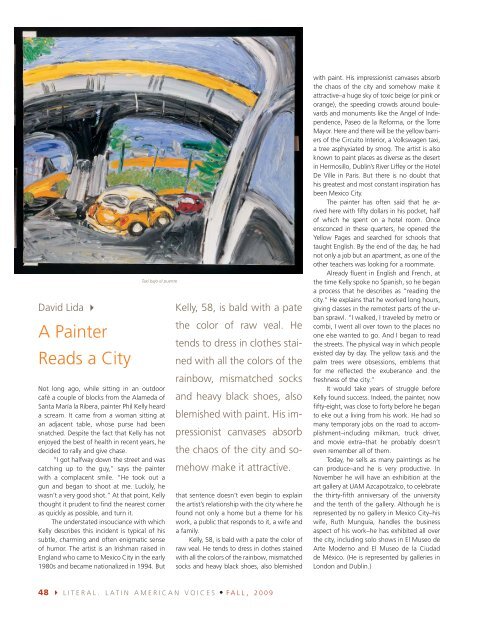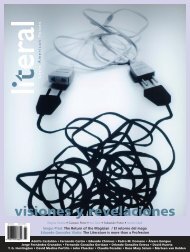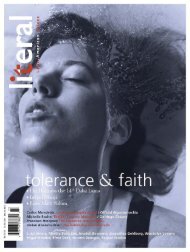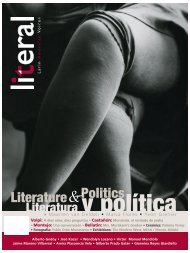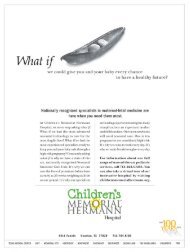Giobany Arévalo > Gabriela Torres Olivares >Anuar Jalife - Literal
Giobany Arévalo > Gabriela Torres Olivares >Anuar Jalife - Literal
Giobany Arévalo > Gabriela Torres Olivares >Anuar Jalife - Literal
Create successful ePaper yourself
Turn your PDF publications into a flip-book with our unique Google optimized e-Paper software.
David Lida <br />
A Painter<br />
Reads a City<br />
Taxi bajo el puente<br />
Not long ago, while sitting in an outdoor<br />
café a couple of blocks from the Alameda of<br />
Santa María la Ribera, painter Phil Kelly heard<br />
a scream. It came from a woman sitting at<br />
an adjacent table, whose purse had been<br />
snatched. Despite the fact that Kelly has not<br />
enjoyed the best of health in recent years, he<br />
decided to rally and give chase.<br />
“I got halfway down the street and was<br />
catching up to the guy,” says the painter<br />
with a complacent smile. “He took out a<br />
gun and began to shoot at me. Luckily, he<br />
wasn’t a very good shot.” At that point, Kelly<br />
thought it prudent to fi nd the nearest corner<br />
as quickly as possible, and turn it.<br />
The understated insouciance with which<br />
Kelly describes this incident is typical of his<br />
subtle, charming and often enigmatic sense<br />
of humor. The artist is an Irishman raised in<br />
England who came to Mexico City in the early<br />
1980s and became nationalized in 1994. But<br />
Kelly, 58, is bald with a pate<br />
the color of raw veal. He<br />
tends to dress in clothes stai-<br />
ned with all the colors of the<br />
rainbow, mismatched socks<br />
and heavy black shoes, also<br />
blemished with paint. His im-<br />
pressionist canvases absorb<br />
the chaos of the city and so-<br />
mehow make it attractive.<br />
that sentence doesn’t even begin to explain<br />
the artist’s relationship with the city where he<br />
found not only a home but a theme for his<br />
work, a public that responds to it, a wife and<br />
a family.<br />
Kelly, 58, is bald with a pate the color of<br />
raw veal. He tends to dress in clothes stained<br />
with all the colors of the rainbow, mismatched<br />
socks and heavy black shoes, also blemished<br />
48 LITERAL. LATIN AMERICAN VOICES FALL, 2009<br />
with paint. His impressionist canvases absorb<br />
the chaos of the city and somehow make it<br />
attractive–a huge sky of toxic beige (or pink or<br />
orange), the speeding crowds around boulevards<br />
and monuments like the Angel of Independence,<br />
Paseo de la Reforma, or the Torre<br />
Mayor. Here and there will be the yellow barriers<br />
of the Circuito Interior, a Volkswagen taxi,<br />
a tree asphyxiated by smog. The artist is also<br />
known to paint places as diverse as the desert<br />
in Hermosillo, Dublin’s River Liffey or the Hotel<br />
De Ville in Paris. But there is no doubt that<br />
his greatest and most constant inspiration has<br />
been Mexico City.<br />
The painter has often said that he arrived<br />
here with fi fty dollars in his pocket, half<br />
of which he spent on a hotel room. Once<br />
ensconced in these quarters, he opened the<br />
Yellow Pages and searched for schools that<br />
taught English. By the end of the day, he had<br />
not only a job but an apartment, as one of the<br />
other teachers was looking for a roommate.<br />
Already fl uent in English and French, at<br />
the time Kelly spoke no Spanish, so he began<br />
a process that he describes as “reading the<br />
city.” He explains that he worked long hours,<br />
giving classes in the remotest parts of the urban<br />
sprawl. “I walked, I traveled by metro or<br />
combi, I went all over town to the places no<br />
one else wanted to go. And I began to read<br />
the streets. The physical way in which people<br />
existed day by day. The yellow taxis and the<br />
palm trees were obsessions, emblems that<br />
for me refl ected the exuberance and the<br />
freshness of the city.”<br />
It would take years of struggle before<br />
Kelly found success. Indeed, the painter, now<br />
fi fty-eight, was close to forty before he began<br />
to eke out a living from his work. He had so<br />
many temporary jobs on the road to accomplishment–including<br />
milkman, truck driver,<br />
and movie extra–that he probably doesn’t<br />
even remember all of them.<br />
Today, he sells as many paintings as he<br />
can produce–and he is very productive. In<br />
November he will have an exhibition at the<br />
art gallery at UAM Azcapotzalco, to celebrate<br />
the thirty-fi fth anniversary of the university<br />
and the tenth of the gallery. Although he is<br />
represented by no gallery in Mexico City–his<br />
wife, Ruth Munguía, handles the business<br />
aspect of his work–he has exhibited all over<br />
the city, including solo shows in El Museo de<br />
Arte Moderno and El Museo de la Ciudad<br />
de México. (He is represented by galleries in<br />
London and Dublin.)


